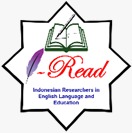Students’ Perception during Negotiation of Meaning in Unfocused and Focused Tasks
DOI:
https://doi.org/10.22219/englie.v4i1.22513Keywords:
focused task, negotiation of meaning, students' perception, unfocused taskAbstract
This current study aimed to determine the students’ perception of using unfocused and focused tasks. The design of the study was qualitative. The subjects of the study were 10 medical students of UPT Balai Bahasa Universitas Malahayati. The data were collected through speaking tests and questionnaires. The speaking test of speaking focused and unfocused was administrated. The students’ utterances will be recorded and described. The data will be analyzed in which types of negotiation of meaning are done by the speakers.The results of the research showed that the student's perception, open-ended interview method aimed at measuring perceptions of unfocused and focused tasks served as the research instrument. The results showed that the two tasks indicated that the unfocused task was enjoyable to most of the students, yet they failed to get input for the development of their language quality because during the negotiation of meaning they focused more on meaning. Moreover, the focused task was enjoyable for higher language proficiency to do. Hence, it could be inferred that the focused task was not suitable for lower language proficiency.
Downloads
References
Arikunto, Suharsimi. (2006). Prosedur penelitian suatu pendekatan praktik. Jakarta: Rineka Cipta.
Arslanyilmaz and Pedersen. (2010). Enhancing negotiation of meaning through task familiarity using subtitled videos in an online TBLL environment. TOJET: The Turkish Online Journal of Educational Technology, 9 (2).
Ellis, R. (1991). Instructed Second Language Acquisition: Learning in the Classroom. Cambridge: Basic Blackwell, Inc.
Farangis, Saeedi. (2013). The effect of negotiation in second language acquisition. Educational. doi: 10.11648/j.edu.20130206.15.
Foster, Pauline, Ohta, & Snyder. (2005). Negotiation for meaning and peer assistance in second language classrooms. Applied linguistics, 26(3), 402-430.
J.C.Richards& W.A. Renandya. (2002). Methodology in language teaching: An anthology of current practice (pp. 167-174). Cambridge: Cambridge University Press.
Jungmi, Kim. (2003). A Study on Negotiation of Meaning in NNS-NNS Interactions: Focusing on Synchronous Computer-Mediated Communication (CMC), 190-210.
Khotimah, S. (2014). The use of problem-based learning to improve students’ speaking ability. In ELT Forum: Journal of English Language Teaching, 3(1).
Kitajima, Ryu. (2009). Negotiation of meaning as a tool for evaluating conversational skills in the OPI. Linguistics and Education 2, 145–171.
Ko, J, Schallert, D & Walters, K. (2003). Rethinking scaffolding; examining negotiation of meaning in an ESL storytelling task. TESOL Quarterly, 37(2), 303-24.
Luciana, Thio. (2005). Negotiation of meaning in communicative tasks. Indonesian Journal of English Language Teaching, 1(1)
Mahpul and & Rhonda, O. (2018). The effect of task complexity in dialogic oral production by indonesian learners. Asian EFL Journal, 20 (6), 33-65.
Mahpul. (2014). Task difficulty in dialogic oral production by Indonesian EFL learners. Perth: Curtin University. Unpublished Thesis
Oroujlou, N. & Vahedi, M. (2011). Motivation, attitude, and language learning. Procedia: Social and Behavioral Sciences, 29, 994 -1000.
Schurz, A., & Coumel, M. (2020). Grammar teaching in ELT: A cross-national comparison of teacher-reported practices. Language Teaching Research. Doi: http://dx.doi.org/10.1177/1362168820964137
Suparman, U. (2009). Qualitative research for language teaching and learning. Bandung: Arfino Raya.
Swain, M. (1985). Communicative Competence: some Roles of Comprehensible input and Comprehensible Output in its Development. In Susan M. Gass and Carolyn G Madden, eds. Input in Second Language Acquisition, 235-253. Rowley, MA: Newbury House.
Swain, M., & Lapkin, S. (1995). Problems in output and the cognitive processes they generate: a step towards second language learning. Applied Linguistics, 16, 371-391. http://dx.doi.org/10.1093/applin/16.3.371
Terrell, T. D. (1986). Acquisition in the natural approach: the binding/access framework. The Modern Language Journal, 70, 213-227.
Yazigi, R. P. S. (2005). Sharing time with young learners, TESL-EJ. Teaching English as a Second or Foreign Language 9(3), 1-26.
Yufrizal, H., Panji, & Nainggolan, Flora. (2017). Consciousness-raising strategy in developing elt students' speaking accuracy. U-Jet, 6 (6).
Yufrizal, Herry. (2007). Negotiation of Meaning by Indonesia EFL Learners. Bandung: Pustaka Reka Cipta,
Downloads
Published
How to Cite
Issue
Section
License
Copyright (c) 2023 Intan Hamzah

This work is licensed under a Creative Commons Attribution-ShareAlike 4.0 International License.
Authors who publish with English Learning Innovation (englie) agree to the following terms:
- For all articles published in English Learning Innovation (englie), copyright is retained by the authors. Authors give permission to the publisher to announce the work with conditions. When the manuscript is accepted for publication, the authors agree to automatic transfer of the publishing right to the publisher.
- Authors retain copyright and grant the journal right of first publication with the work simultaneously licensed under a Creative Commons Attribution-ShareAlike 4.0 International License that allows others to share the work with an acknowledgement of the work's authorship and initial publication in this journal.
- Authors are able to enter into separate, additional contractual arrangements for the non-exclusive distribution of the journal's published version of the work (e.g., post it to an institutional repository or publish it in a book), with an acknowledgment of its initial publication in this journal.
- Authors are permitted and encouraged to post their work online (e.g., in institutional repositories or on their website) prior to and during the submission process, as it can lead to productive exchanges, as well as earlier and greater citation of published work (See The Effect of Open Access).
This work is licensed under a Creative Commons Attribution-ShareAlike 4.0 International License.
















1.png)












